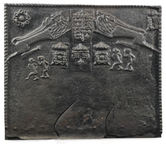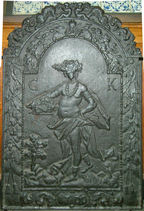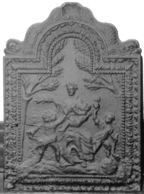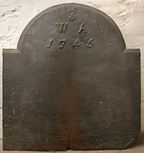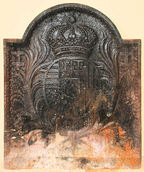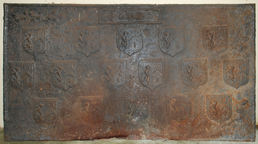-
262
Description: Rectangular; twisted rope edging (top and sides); top centre, crowned Tudor royal shield (over-pressed) between a leopard passant guardant sinister (on the left) and a leopard passant (on the right); below, crowned shield bearing initials, KH, above a fleur-de-lys, between two crowned roses; below each leopard, a pair of 'imp' figures, the left of each with both arms lowered, the right its right arm raised; right top corner, a crowned rose; left top corner, and uncrowned rose.
Notes: One of the 'Royal' series. Christie's Interiors - Oak Edition, South Kensington (Sale 5369), 4 November 2008, lot 257 (£3,250).
Inscription: KH
Arms: Tudor Royal (prob. Henry VIII)
- Decoration tags:
- rectangular (shape)
- rope (edging)
- carved stamps
- heraldic
- armorial
- royal
- text
- animals
- objects
Manufactured: in the mid 16th century in the Weald area of England.
Current location: not known.
- Attached to series:
- Royal series
-
83
Description: Arched rectangular shaped central panel, bead-and-pellet edging, semi-naked male figure, wearing a floral head-dress and carrying a basket of produce, initials in top corners; arched rectangular shaped border, fillet edging, symmetrical festoons of foliage, floral scrolls at base, date in an oval cartouche; on top, two putti, two dolphins and scrolled foliage, all symmetrical.
Notes: An allegory of Spring, based closely on an engraving, dated 1600, by Hendrik Goltzius (1558-1617); one of a series of large firebacks of similar date, all bearing the initials, GK.
Copies of this fireback are known.
Inscription: G K / 1700
- Decoration tags:
- 'Dutch' (shape)
- fillet (edging)
- whole carved pattern
- individual letters
- date stamp
- pictorial
- allegorical
- text
- humans
Manufactured: in 1700 possibly in the Siegerland area of Germany.
Current location: Guildford Museum, Guildford, Surrey, England.
Museum number: S,7111 (part of the Guildford Museum museum group)
Citation: Pesch, D., 1982, Herdgussplatten (Rheinland-Verlag, Koln).
- Attached to series:
- 'Dutch' GK series
-
138
Description: 'Dutch' style; arched rectangular shaped central panel with bead edging, figure of Charity holding a baby in her left arm and an olive branch in her right, two other children stand on each side of her, one holding a burning heart, trees in the background; arched rectangular shaped border with fillet edging and a repeated leaf pattern; on top a clam shell between two symmetrical serpents.
Notes: Typical type of fireback produced in Germany by Dutch pattern makers; the central panel was made separately for insertion into different borders; this border is a relatively simple type; the portrayal of Charity is derived from the 'Iconologia' of Cesare Ripa. Formerly part of the Ade Collection (from Grove Hill, Hellingly, Sussex).
Copies of this fireback are known.
- Decoration tags:
- 'Dutch' (shape)
- fillet (edging)
- carved pattern panels
- allegorical
- humans
- plants
Manufactured: in the mid to late 17th century possibly in the Siegerland area of Germany.
Current location: Hastings Museum and Art Gallery, John's Place, Bohemia Road, Hastings, East Sussex, England.
Museum number: HASMG: 1952.51.40 (part of the Hastings Museum museum group)
Citation: Lloyd, N., 1925, 'Domestic Ironwork I', Architectural Review, 58, pp. 58-67.
- Attached to series:
- 'Dutch' Miscellaneous Firebacks
- Charity firebacks
-
190
Description: Arched rectangle; bevelled edge to arch and top of shoulders; initials at centre top of arch, in triangle 'S' at top; date below initials.
Notes: Possibly the work of David Robertson (1716-93), the King's Smith, whose iron grates are commonly to be found in houses designed by the prominent Scottish architects, Robert, John and James Adam, of whom he was a kinsman; the form of the plate is typical of grate-backs Robertson made in a variety of sizes, notably at Dumfries House, Ayrshire, although the lack of evidence of fixings suggest that this may have been made to be free-standing. Until 1756/7 Robertson had his forge in a tenement in Niddery's Wynd, Edinburgh, between High Street and Cow Gate, next door to John Adam's premises, although it is not known if he had a foundry there.
Inscription: S / W A / 1745
- Decoration tags:
- arched rectangular (shape)
- individual letters
- individual numbers
- text
Manufactured: in 1745 possibly in the Edinburgh area of Scotland.
Current location: Hill Top, Sawrey, Hawkshead, Hawkshead, Cumbria, England.
Museum number: 641831 (part of the National Trust museum group)
- Attached to series:
- Date & initials firebacks
-
361
Description: Quasi-rectangular; twisted rope edging on top and sides; cavetto-moulded-edged rectangle top centre, enclosing date between initials; 17 shields of Ayloffe impaling Sulyard in three rows (5-6-6); Ayloffe: sable, a lion rampant Or, collared gules, between three crosses formy of the second; Sulyard: argent, a chevron gules between three pheons inverted sable.
Notes: William Ayloffe (c1535-1584) of Hornchurch, Essex, Justice of the Court of Queen’s Bench, married (c1560) Jane, dau. of Sir Eustace Sulyard, of Runwell, Essex. The initials 'CT' are likely to be those of Charles Tyler, a founder whose working life and that of his family have strong parallels with the occurrence of these firebacks.
Inscription: C.1.6 2.0.T
Arms: Ayloffe impaling Sulyard (William Ayloffe of Bretons, Hornchurch)
- Decoration tags:
- sub-rectangular (shape)
- rope (edging)
- carved stamps
- individual letters
- individual numbers
- armorial
- text
Manufactured: in 1620 possibly at Hawkhurst Furnace in the Weald area of England.
Current location: Scotney Castle, Lamberhurst, Kent, England.
Museum number: 791898 (part of the National Trust museum group)
- Attached to series:
- Ayloffe series
- Personal armorial firebacks
-
870
Description: Arched rectangular shape with ovolo-moulded edging and narrow extensions to sides; central shield bearing arms with lion rampant supporters and motto scroll beneath; above, a marquesal coronet; date split between top corners; inserted initials above coronet; on top of arch, two downward facing dolphins with tails entwined.
Notes: The arms are of the family of Henry Pierrepont, marquess of Dorchester and earl of Kingston-upon-Hull, of Thoresby Hall, Nottinghamshire (blazon: argent semi of cinquefoils gules, a lion rampant sable), with the motto: Pie Repone Te (Place yourself piously), a pun on the name, Pierrepont. Confusingly, the marquisate of Dorchester was created twice for members of the same family. In 1645 it was created for Henry Pierrepont, 2nd earl of Kingston-upon-Hull, becoming extinct on his death without surviving male issue in 1680. It was created again for Evelyn Pierrepont, the 5th earl of Kingston in 1706 who was subsequently elevated to the dukedom of Kingston in 1715. The original casting may therefore have dated to between 1645 and 1680 or between 1706 and 1715. The initials may be related to the Halls, the 2nd Duke of Kingston's mother's family, and were probably added with the date in 1728. Woolley & Wallis auction, Salisbury, 8 Jul 2014, lot 518 (£250); Lyon and Turnbull auction, Edinburgh, 1 Sep 2021, lot 10.
Copies of this fireback are known.
Inscription: A H / 17 28 / PIE REPONE TE
Arms: Pierrepont, Marquess of Dorchester
- Decoration tags:
- quasi-arched rectangular (shape)
- ovolo (edging)
- whole carved pattern
- individual letters
- armorial
- text
Manufactured: in 1728 in England.
Current location: in private hands, not known.
- Attached to series:
- Personal armorial firebacks
- Pierrepont series
-
509
Description: Arched rectangular central panel with astragal and fillet edging; Phaëton riding Apollo’s chariot across the skies, the sun to the left behind clouds, a lion on ground below, between two trees; arched rectangular border with fillet edging; trailing convolvulus leaves surround the central panel; on top, earl’s coronet above an illegible character, between mirrored, swirled foliage.
Notes: The illustration upon which the design has been based has not been identified, save that it figures in book II of Ovid's Metamorphoses. The convolvulus border is a common feature of this series of firebacks and can be compared with other. The wooden pattern from which this casting was made survives in the collection of the Sussex Archaeological Society (no. 928).
- Decoration tags:
- 'Dutch' (shape)
- fillet (edging)
- whole carved pattern
- planklines
- pictorial
- mythological
- animals
- humans
- objects
Manufactured: in the early 18th century at Ashburnham Furnace in the Weald area of England.
Current location: Penhurst Manor, Penhurst, East Sussex, England.
- Attached to series:
- TAN series
- British 'Dutch' style firebacks
-
820
Description: Arched rectangular shape; wide fillet and egg-and-dart ovolo edging; central oval armorial with fillet edging, palm fronds on each side, tied below, a crown above; in each top corner, the cross of Lorraine.
Notes: The arms are those of Duke Leopold I of Lorraine, who also bore the titles of King of Jerusalem, Hungary and Aragon, and Duke of Anjou, Bar, Gueldre and Juliers.
Arms: Leopold I, Duke of Lorraine and Bar (1680-1729)
- Decoration tags:
- arched rectangular (shape)
- ovolo, egg and dart (edging)
- whole carved pattern
- armorial
Manufactured: in the early 18th century possibly in the Lorraine area of France.
Current location:, not known.
- Attached to series:
- Foreign armorial firebacks
-
699
Description: Rectangular; twisted rope edging on top and sides; cavetto-moulded-edged rectangle top centre, enclosing date between initials; 16 shields of Ayloffe impaling Sulyard in three rows (5-6-5); Ayloffe: sable, a lion rampant Or, collared gules, between three crosses formy of the second; Sulyard: argent, a chevron gules between three pheons inverted sable.
Notes: William Ayloffe (c1535-1584) of Hornchurch, Essex, Justice of the Court of Queen’s Bench, married (c1560) Jane, dau. of Sir Eustace Sulyard, of Runwell, Essex. The initials 'CT' are likely to be those of Charles Tyler, a founder whose working life and that of his family have strong parallels with the occurrence of these firebacks. An identical fireback is in a house at Cowden, Kent, and a broken example is at Wool House, a National Trust property at Loose also in Kent; small variations in the alignment of the shields are apparent.
Copies of this fireback are known.
Inscription: C.1.6.0.1.T
Arms: Ayloffe impaling Sulyard (William Ayloffe of Bretons, Hornchurch)
- Decoration tags:
- rectangular (shape)
- rope (edging)
- carved stamps
- individual letters
- individual numbers
- armorial
- text
Manufactured: in 1601 possibly at Bedgebury Furnace, Goudhurst in the Weald area of England.
Current location:, not known.
- Attached to series:
- Ayloffe series
- Personal armorial firebacks
-
300
Description: Arched rectangular shaped central panel with bead-and-pellet edging on a broad fillet; Jupiter in his chariot drawn by eagles; above are clouds, below is a landscape; arched rectangular shaped border with fillet edging, with a symmetrical scrolled wire design; the monogram, SHR, bottom centre; above is a symmetrical design of scrolled floral tendrils.
Notes: The design is derived from a personification of the planet, Jupiter, in 'Planetarum effectus et eorum in signis zodiaci', by Marten de Vos (1585).
Copies of this fireback are known.
Inscription: SHR
- Decoration tags:
- 'Dutch' (shape)
- fillet (edging)
- whole carved pattern
- pictorial
- mythological
- monogram
- animals
- humans
- objects
Manufactured: in the late 17th to early 18th century in England.
Current location: Powis Castle, Welshpool, Powys, Wales.
Museum number: 1180886 (part of the National Trust museum group)
Citation: Dawson, C., 1903, 'Sussex Iron Work and Pottery', Sussex Archaeological Collections, 46, pp. 1-54.
Citation: Gardner, J. S., 1898, 'Iron Casting in the Weald', Archaeologia, 56, 1, pp. 133-164.
- Attached to series:
- SHR series
- British 'Dutch' style firebacks
- De Vos Planets series
